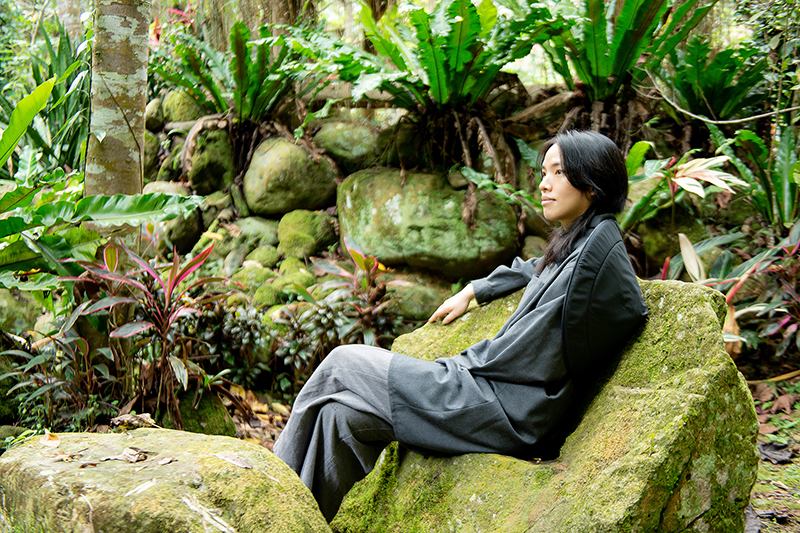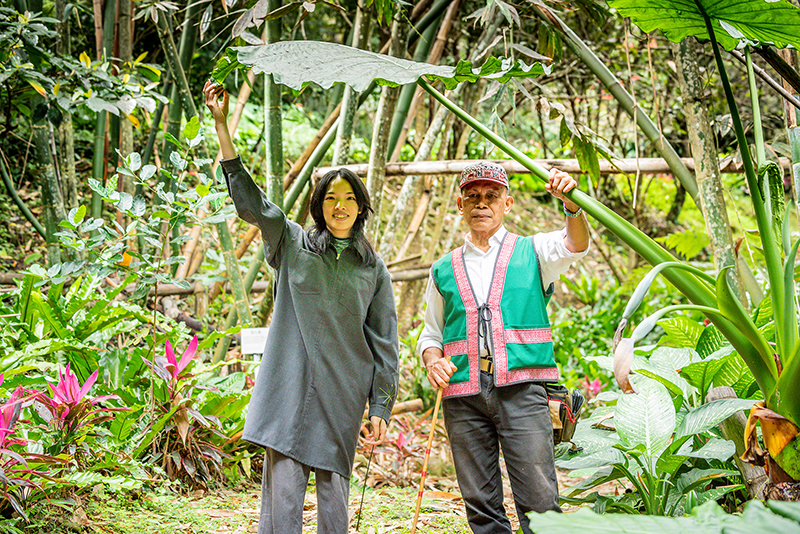How much did you know about Taiwan Plains Indigenous Peoples at first?

In the beginning, my knowledge about them was zero, but now it has gone from zero to one. I used to think that the Taiwan Plains Indigenous Peoples have been profoundly assimilated into and affected by the Non-indigenous Chinese society, but I am surprised to find out that the Pazeh language has been so well preserved. I learn from the mentor that this would not have been possible without the endeavors of the church, it turned out that their history and means of cultural preservation are more like those of their counterparts based in the mountains. Unlike that of the Non-indigenous Chinese people, part of the Taiwan indigenous culture was recorded and preserved by the Wester missionaries who came during the Qing dynasty.
What impressed you most today?

I knew almost nothing about the history of the Taiwan Plains Indigenous Peoples before today. I have only learned from the literature left by foreign scholars about Taiwan mountain indigenous peoples that there had been quite a few indigenous females married to Japanese, the Non-indigenous Chinese, and mainlanders in those days, for they spoke two languages and could therefore serve as interpreters in negotiations. As for me, what I know about the Taiwan Plains Indigenous Peoples is that thanks to their position in the middle ground, they play the role of intermediates to facilitate the communication and cultural exchanges between the non-indigenous and other indigenous ethnic groups. Take the mentor for example. As a Pazeh who also speaks fluent Taiwanese, now he is serving as a bilingual guide to introduce his native culture in the language spoken in the lowlands.

When did you begin to learn about indigenous culture? Through what channels?

I have learned almost nothing about that while in school. All my knowledge about Taiwan indigenous peoples was self-taught by searching for information on my own. Most people around me are not interested in the indigenous communities at all, be it their culture or situations. A young indigenous man once told me that some of his colleagues, who were also indigenous, cared nothing about issues related to them and considered themselves urban people. This gives me a feeling that indigenous people are hampered by the burden of their identity when it comes to the passing on of indigenous culture. It seems that they are constrained by an overemphasis on indigenousness, which requires them to live up to what people expect them to be or do.
In 2013, I once thought of drawing a fictional story about the Austronesian peoples. The idea was inspired by the autobiography of a Western missionary who ventured into the Amazon jungle to preach to local indigenous peoples who had never come into contact with other humans and record their languages. I intended to draw a fictional comic with similar settings based on this real story, featuring a foreign missionary traveling to an indigenous village isolated from outside civilization. But so far, I have only finished the beginning of a short story, for if the story is not backed up by a comprehensive, detailed research of historical evidence and facts, the storylines would appear lacking in depth. It did not remember to me that Taiwan has its own indigenous peoples until later as I went on to look for more information for the project. But the creation of this story was therefore suspended for several years. It was not until 2016 that the second episode came out. Later, when I was thirty, I was commissioned by Creative Comic Collection to draw short comics. I approached the indigenous advocacy groups who protested on Ketagelan Boulevard to gain first-hand observation and understanding of indigenous issues. That was my very first time coming in contact with Taiwan indigenous people.
Have you heard about any indigenous myths or legends?
 I have read about the legend of the sacred stone of the Atayal. My interest in their history and culture was triggered by a previous visit to Cilan Mountain, where I found many of the large sacred trees there were named after ancient Chinese sages, such as Confucius. I felt it was quite out of place, so I did some research to find that the place was run by the Veterans Affairs Council. Later I learned that the mountain was in fact part of the Atayal’s traditional territories. Throughout the process of researching, I began to gain a rudimentary understanding of the people of Atayal. I did much research about the Atayal and Bunun by combing historical documents left by the Japanese, which had detailed descriptions of the customs of Taiwan indigenous peoples. For example, the Atayal used bird divination as a basis for deciding the good or ill of a given circumstance by observing the flight direction of birds. The Bunun, on the other hand, had such stories as the myth of the flood, the tale of the lazy married woman, and the legend of two suns. I also remember that some indigenous groups in southern Taiwan had the tales of “black dwarves,” a legendary people who had been extinct. I am an enthusiast who loves researching historical documents, but so far, I haven’t had a chance to come into contact with the Atayal people in person.
I have read about the legend of the sacred stone of the Atayal. My interest in their history and culture was triggered by a previous visit to Cilan Mountain, where I found many of the large sacred trees there were named after ancient Chinese sages, such as Confucius. I felt it was quite out of place, so I did some research to find that the place was run by the Veterans Affairs Council. Later I learned that the mountain was in fact part of the Atayal’s traditional territories. Throughout the process of researching, I began to gain a rudimentary understanding of the people of Atayal. I did much research about the Atayal and Bunun by combing historical documents left by the Japanese, which had detailed descriptions of the customs of Taiwan indigenous peoples. For example, the Atayal used bird divination as a basis for deciding the good or ill of a given circumstance by observing the flight direction of birds. The Bunun, on the other hand, had such stories as the myth of the flood, the tale of the lazy married woman, and the legend of two suns. I also remember that some indigenous groups in southern Taiwan had the tales of “black dwarves,” a legendary people who had been extinct. I am an enthusiast who loves researching historical documents, but so far, I haven’t had a chance to come into contact with the Atayal people in person.

This is your first time in the Pazeh community spending time with the locals. How did you feel about that?

Some of them are funny. I am not sure if I can compare this experience to the contemporary “cyberpunk,” which is typically used to describe the impression given by the neon lights in Hong Kong along with a sense of science and technology. This is how I feel about some of Taiwan’s indigenous communities that demonstrate a fusion of traditional elements and modern techniques, which is playful and very much like a kind of indigenous aesthetics.
The experience of working with the Pazeh instructors this time is rather different from those I had with other mountainous indigenous peoples before. The feeling is quite different. Take the Bunun for example. The villagers I met were older and had worked in Taipei when young before they returned to engage in farming and doing business. But the elders from the village tended to criticize them for being too unconventional and going astray from the Bunun traditions. The views of the older and the younger generations were divergent in many aspects. Those who returned to their hometowns to start a new career might have to make efforts to gain the recognition and approval of the elders. As for the Pazeh, on the other hand, the problems they are likely to encounter are completely different since they have strong solidarity enhanced by the church and are almost of the same generation.
The last time you had contact with indigenous people was to work on placemaking. How is this time different from your previous experience?

Many of my friends are engaged in placemaking, which is a multi-faceted approach to the planning, design, and management of public spaces. Take the Zhengbin Fishing Harbor in Keelung for example, festivals are held to attract the participation of local residents. Such a trendy approach of using popular elements to draw people’s attention is completely different from that of indigenous peoples, whose cultural revitalization is not achieved instantly but through gradual accumulation and cooperation with academic circles, relying on scholars and experts for their research results or study of historical documents. Daway Abuk, one of the instructors, pays particular attention to the authenticity of historical data. This is because while writing research papers, some authors might seek to reach the desired conclusions by using the data or facts that meet their needs. Another case is the color of the traditional Pangcah costumes. It used to be black but was changed to red for the sake of stage performances. However, it’s quite difficult to prove this argument. Once a false argument is proposed from the very beginning, it’s possible to give rise to more incorrect assumptions. This is why Mr. Daway Abuk is particular about the overall historical accuracy and strives to avoid spreading erroneous ideas in the process of cultural revitalization, fearing that the results might radically deviate from the tradition.
Today I learn that the Pazeh people focus their revitalization on the language, while less attention is paid to other aspects. This makes me worry that it could hinder the passing on of their culture. On the other hand, though, it would be wrong to think that the people of Pazeh are significant simply because they have a rich culture and that they can only be recognized by doing something that fulfills the expectations of the public. After all, the existence of the Pazeh is an undeniable fact, and they do have their own culture. How to preserve and keep it alive, however, is an issue to be considered in the next stage. It’s just that the threshold for learning a language is pretty high, which might be challenging for those who are getting on in years. The task is much more difficult compared with experiencing the culture through daily activities.




